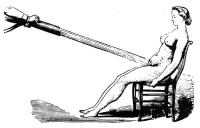Freud Out Loud: Civilization and its Discontents – A Marathon Reading
“The inclination to aggression constitutes the greatest impediment to civilization.” – SIGMUND FREUD, 1929 Why is the world so violent? Why can’t civilization contain it? Freud knows! Few thinkers understand human aggression as powerfully as the founder of psychoanalysis, Sigmund Freud. His 1929 essay, “Civilizations and Its Discontents,” remains the definitive text on human destructiveness. As beheadings, school shootings, war, police brutality and sexual violence continue unabated contemporarily, its relevance is undeniable. “Men are not gentle creatures,” Freud wrote, “but … creatures whose instinct (is) aggressiveness.” Judson Memorial Church and New Books in Psychoanalysis will host a reading of Freud’s seminal essay to ring in 2015, organized by Tracy Morgan, Will Braun, ...Read More
Matthew Oyer: Hysteria and the Psychoanalytic Act
“The history of hysteria spans nearly four thousand years: four thousand years of the wilderness of women’s bodies and of manifest destiny, or the attempts of men to push ever further the boundaries of the frontier, four thousand years of shame, of defiance, four thousand years of theater, of desire’s sting and the “infection of the Idea” (Badiou, 2013). Hysteria, from the Greek hystérā, womb, hysterikós, of the womb. The womb that wanders. As the father of Western thought, Plato, described, “The uterus was rebellious and masterful, like an animal disobedient to reason, and maddened with the sting of lust” (Plato, 1963/1973, p. 1210). Desiring, violent, creaturely stuff. Throughout these four thousand years, the myriad ways hysteria has been conceptualized, and all of its rapidly flu...Read More
Feminine Pathologies: An EJP Special Edition edited by Fernando Castrillon and Jamieson Webster
“Of course, what is lost in this conception of hysteria is precisely one of its most fundamental characteristics; hysteria moves and grows beyond the confines of whatever conceptual grid we try to fit it into. If it’s not here, now, it’s there; wherever we have made there out to be (Victorian era, “pain clinics”, fibromyalgia, eating disorders). To listen to and for hysteria is to move, with our analysands, with our bodies, moving psychoanalytically, thereby comprising a psychoanalytic movement. Which is to say that hysteria lives in the light of metaphor, and yes, the drift of metonymy. So where does hysteria move now? Where does it threaten to break the surface? The essays in this issue speak directly to this question. They investigate, they analyze a linguistic-logical domain open...Read More
Claude-Noële Pickmann: Suppléance by the Symptom: A Case of Anorexia
“The feminine Oedipal structure as Freud discerned it in his young hysteric patients in the first half of the twentieth century has taught us that the question “what is a woman?” is first posed by a girl to her mother. Later, upon finding that the maternal response has only misled her, she chooses to pose the question to her father, as if, in the course of her searching, she had the presentiment that an appeal to the father’s desire was likelier to enlighten her as to what awaits her as a woman than the connection she maintains with her mother, privileged as this is. Whether Dora or the case of the young female homosexual, these patients showed Freud—well before he was able to properly gauge the measure of the problematic—that an Oedipal girl chooses to avail herself of the father, ...Read More







